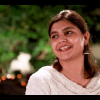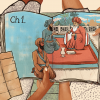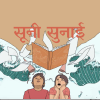She is also a research scholar and runs a dance institute called Trishna. She currently serves as the Head of the Dance Department at Telugu University.
Following is an edited interview with Dr Alekhya Punjala on the learning and teaching process of Kuchipudi. The interview was conducted telephonically by Kuchipudi performer and research scholar Madhulika Srivasta.
Madhulika Srivasta (MS): What are your views on the concept of guru parampara (traditional way of learning from a guru)?
Alekhya Punjala (AP): I believe this is a very apt concept in the field of Fine Arts. You can very well learn under any teacher. But only when a guru holds your hand and takes it forward, will you grow as a performer. It also means that the student will have complete faith in the guru. The idea of guru parampara doesn’t really have much of a place in any other field, but in the field of Fine Arts it is most essential. People may feel it has been unnecessarily glorified, but I don't think so.
MS: What is the general way of teaching Kuchipudi? Has it undergone any changes in the last decade?
AP: Very much. Many changes have happened. We have come very far from the tradition of guru-shishya parampara that used to exist. For, this tradition did not just mean learning from a teacher, it was a way of living. One would go to the guru, wait for the guru to get into the proper mood, and then the guru would teach. The student spent considerable time with the guru and so on. It would not happen at the drop of a hat. The students would spend hours, days and years learning from their gurus. The gurus, on the other hand, took the students under their wings and guided them. What we see today is that a school is set up where forty to fifty students are taught in the same fashion. But in those days, the gurus understood and recognised the strengths and weaknesses of every student. Personal attention was given to each of them. It would be a process of sculpting every single child. From that kind of learning process under a teacher, with no other distractions, we have moved on to the kind of learning in dance institutions where a teacher teaches without any personal import.
Today, learning dance is an extracurricular activity rather than a 24/7 thing. The teachers teach within a time frame, and so she/he is compelled to make it into a kind of bullet-point presentation. The time spent with a student has drastically reduced. Within that time frame, the teacher is expected to cover so much, and it becomes taxing for him/her. When I was learning dance, I didn’t have the opportunity of getting an academic degree at the end of it. Now it has changed. You can get degrees in dance. It is a good thing, no doubt, but it has its difficulties. Here, as a teacher, I cannot choose my students. I have to teach anybody who comes to me. Out of ten students, I can only vouch for four or five that might turn out to be good artistes or, sometimes, even just good learners. But then the academic focus also means that many interested candidates get the opportunity to learn the art form.
MS: What are the qualities that a student of Kuchipudi is expected to possess or develop in order to master the form?
AP: The very first thing you need is patience. There are no quick solutions and answers. This is something the child, the parent, as well as the teacher, must keep in mind. Art cannot come instantly. Every student will have different levels of imbibing and reciprocating. We have to accept the different capacities each child is endowed with, recognise them, and then work on them accordingly. From the student’s end, daily practice is a must. To practice dance doesn’t always have to mean getting up and dancing, but you can simply think of it, dance mentally and just be with it. It surely helps. Of course, passion and dedication are needed to acquire a certain amount of excellence. Another important thing is that every parent must include an art form in the routine of the child. It can be any art. Every child should explore. They must just learn; they don’t have to become a dancer per se, but art does make one a better human. I am absolutely convinced that art makes one a beautiful person.
MS: How was your experience of learning Kuchipudi under gurus?
AP: I have had the fortune of being blessed with wonderful gurus at every stage of my life. I am also very grateful to my mother who initiated me into this art form. Sri Kelucharan Mohapatra was my mentor, and he encouraged me and made me see the beauty of dance. Under Dr Uma Rama Rao I received plenty of strict training that made the dancer in me blossom. When I was searching for a guru, I was sure I didn’t want someone whom I would fear. I had heard stories about rude gurus and I was sure I wanted someone who would understand my strengths. My guru Dr Uma Rama Rao recognised that and made me what I am today. She was truly my guru, mentor, friend, philosopher and guide. We had regular one-to-one classes. We worked a lot on my stamina, did lots of practice together, and multiple repetitions was a routine. I can happily say my guru and I had a fantastic tuning with each other. I am grateful to her for everything!
MS: Please share your experience of teaching Kuchipudi.
AP: For me, I have tried to be the guru that I sought for as a student. I always felt that students should be able to relate with me in dance and otherwise. I am their teacher in class, aunty or akka outside. I am very strict in the class but outside of it, we share a friendly relationship. I want to share my passion with them so that they become passionate about Kuchipudi in turn.
I begin with angika (body language) training as that is how I can train them to bring the body under control. Until the angika is in place, nothing else can be worked upon. Even if it takes time I work on it so that later on it becomes easier for the student, and me, to handle the further nuances of Kuchipudi. I cannot build a good structure on a shaky foundation, and that is what will happen if the technique isn’t right. I ensure that every child has a level of expertise on the angika, and after that, we begin with the traditional pieces. I always choose items based on the age of a child and will not have the same repertoire for all of them.
At college, the students come from different paramparas (traditions) and we make sure to recognise them. Every guru has a baani (style) and we respect that. Art cannot be photocopied, else there will not be any shades in the dance. Once that is done, we bring them to a common platform. We give traditional compositions, which becomes the crux. Following the traditional repertoire, we introduce the theory, and then allow them to explore their choreographies as well. While in a regular dance class, I concentrate on performance, in colleges you are bound by the syllabus. In Kuchipudi, there is the solo format which the students are introduced to; and we also expose them to the Yakshagana technique. We teach pieces like Bhama Kalapam in the process. We also teach them the small precautions that they should keep in mind while they themselves are attempting choreography. Every item taught has a different format, we teach the salient features and also how to work on every piece in terms of its focus, the layers you need to explore, the composers, etc. The idea is to open and knock on the doors and say: see all this is there!
Basically, as a guru, the aim is to give every single student an all-round exposure to Kuchipudi.
MS: Could you explain how theory plays a role in an oral tradition format?
AP: When I was learning, the thrust was more on performance. Only when it was time for my exams I would concentrate on theory. In a dance class, the focus is certainly on practical dancing. But theory indeed makes you more conscious. Knowledge does help and, in a way, it is a necessity. So many times you see blunders happening with the performing concept, execution, etc. Knowing the theory puts you in a better perspective when you perform because then you are going on stage armed with knowledge, otherwise you are just a parrot, imitating what you were taught. I am not saying everyone should know all the theories of our treatises by heart but at least one should know what they are doing!













